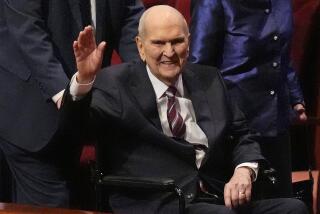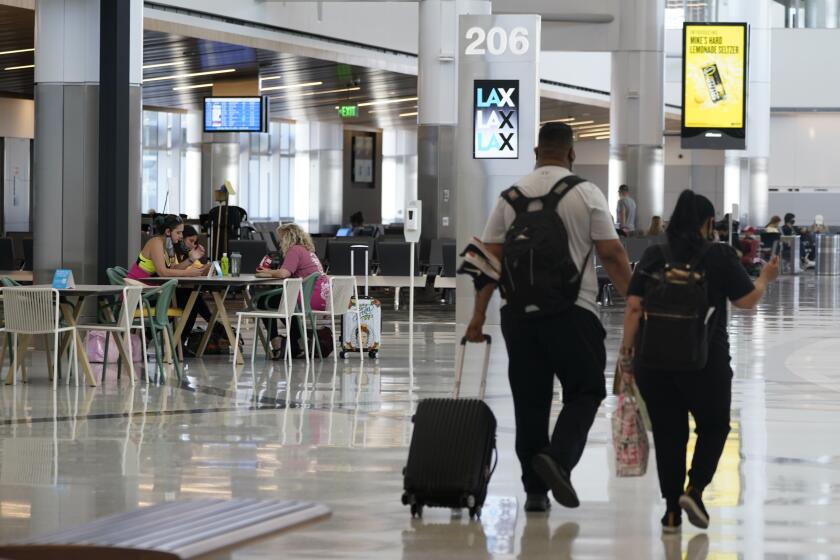Mormons Continue the Long Tradition of Missionary Work
- Share via
PANORAMA CITY — Their trademark bicycles parked outside, Elders Bundy and Winterton paid a call on one Curtis Hawkins recently and, taking turns with their host, alternately read about baptism from the Book of Mormon and the Bible.
Hawkins, a 45-year-old ex-convict, had been immersed in Scripture study for the last year at two evangelical churches, but he had yet to take the plunge into either church’s baptismal pool. The neatly dressed Mormon missionaries, their 20-year-old faces cleanshaven, were hoping he would instead pick the Church of Jesus Christ of Latter-day Saints.
“It doesn’t say [in the Bible] he went over there,” Hawkins politely demurred when the pair told him of Jesus appearing to prophets in the Americas. But he agreed to meet with them again. They even went to each other’s church services.
Two hundred years after Franciscan friars from Spain established the San Fernando Mission to indoctrinate Native Americans in Catholicism, evangelism is still alive within today’s multiethnic Valley. But few groups so closely recall the demanding, far-reaching proselytizing of those 18th century priests as the Mormon Church, which encourages mainly young men to volunteer for two years of 12-hours-daily missionary work that is as celibate and spartan as any priest’s life.
For most of its history, the Mormon Church has won new adherents only amid difficulty. Declaring that true Christianity needed to be rescued from modern distortions, Joseph Smith in 1830 formed a new church around the Book of Mormon, which he claimed he had translated from engraved golden plates given to him by an angel. Though the church abolished polygamy in 1890, its extra scriptures and distinctive doctrines still cause Catholic and Protestant churches to regard it as a Christian sect.
Lately, the church has been emphasizing cooperation with other religious bodies and participation in community service--a relatively new strategy that may ultimately open more doors. In the last decade, Mormon Church members have joined in emergency relief efforts, become key members of local interfaith councils and volunteered at hospitals, schools and other institutions.
But the unique Mormon practice of encouraging young adults to do a missionary stint continues to be the principal method of expanding the worldwide church based in Salt Lake City. In fact, the majority of the 10 million Mormons now live outside the United States, due to spectacular conversion rates in South America and Africa.
From the San Fernando Valley to Mammoth, with the Santa Clarita and Antelope valleys in between, the church operates its own San Fernando Mission district, which in 1996 accounted for 1,000 conversions out of 15,000 statewide. About 180 Mormon missionaries currently travel the district, often on bicycles because they are easy to park in urban areas.
Missionary work is not a requirement of young Mormons, and less than half the church’s young men volunteer. Those who do, however, support themselves through their own savings, parents’ help and possibly church aid. Volunteers may spend up to two months in intensive training, especially if they need to sharpen foreign-language skills. In the field, they live frugally in apartments without televisions and are supervised by more experienced colleagues, who in turn report to adult missionaries.
The commitment can be daunting, and there are dropouts. “They are very few, but the numbers are not disclosed to the public,” said Keith Atkinson, the Mormon public affairs director for Southern California. Some young Mormons “leave their missions early for reasons other than illness, and some go through the motions only because of pressure from home,” said Robert Lively, a University of Maine scholar who is writing a book on Latter-day Saint missionaries.
A sociologist of religion, Lively said his research was prompted by visiting missionaries who told his classes about their disciplined lives--rising at 6:30 a.m., no visits home, no dating or popular music, and the usual Mormon prohibitions against tobacco, alcohol, tea and coffee. “The students are amazed that their peers would subject themselves to such rigor,” Lively said.
Though they did not lead Hawkins, a self-described former “dope fiend,” into the Mormon Church, Mike Bundy, of Shelley, Idaho, and Steve Winterton, who is from Roosevelt, Utah, already had racked up an above-average 20 conversions each through the first 18 months of their assignments.
With their white shirts and ties, name tags, short hair, dark pants and shoes--all of which conform to the Mormon missionary dress code--the pair tend to receive instant recognition from householders answering a knock at the door.
“You do a lot of good work--I see missionaries going by a lot,” said Carole Porter, who talked to Bundy and Winterton on a short canvass in Mission Hills. “As you can see by the statue of the Virgin Mary out front, we are Catholic.” She added that she has a close Mormon friend in Bishop, with whom she often prays.
“Good luck on your mission,” she said as the pair departed.
Less known outside the Mormon Church are the growing ranks of female missionaries, which have risen about 3% in the past four years. Of the 56,000 missionaries currently serving worldwide, 10,800, or 19% of the total, are young women. Another 3,920 missionaries are senior citizens of both genders, Atkinson said.
Young women missionaries must be at least 21 years old (compared to 19 for men), and thus “tend to be more mature and self-confident” than their young male counterparts, said Lively, a non-Mormon who has interviewed about 200 former missionaries in his research.
“Within the last two decades it has been the ‘in’ thing for bright, young Mormon women to postpone marriage and motherhood until they have completed their education, serve on a mission and possibly even worked for a while,” said Lively.
A 25-year-old missionary serving in the Valley, Jennifer Bullock of Eugene, Ore., acknowledged that young Mormon women face “some pressure to find a husband.”
In her own case, Bullock said, she had just graduated from Brigham Young University as an art history major and was considering graduate studies or working.
“More than anything, I always have tried to find out what God wants me to do at certain points in my life,” Bullock said. “I realized that a lot of other people in the world don’t have the blessings and happiness I have, and I wanted to share this.”
Bullock and her missionary partner, Cameron Packer, 22, of Lander, Wyo., make their rounds between Granada Hills and Tarzana in a 1996 Nissan Sentra provided by the church. In her first mission in Ridgecrest, Calif., Bullock went around on a bicycle--despite the church requirement that young women missionaries wear a dress or skirt, nylons and “polishable shoes,” as she put it.
“We use a car because our area is so big and some places are dangerous,” said Packer.
Dogs and bicycle theft are among the most common occupational hazards. Bundy said he once crashed into a man pulling a motorbike out of a driveway, but “while he helped me straighten my bent handlebar, I was talking to him and wound up giving him a Book of Mormon.”
Rejection remains the biggest potential casualty of the job, so the missionaries often cite a church teaching that provides some psychological relief. “It’s not so much that we convert, but whether the Spirit convinces them,” as Winterton put it.
“Missionaries who go to some European countries like Italy may come back with no conversions, but with wonderful experiences,” he added.
Indeed, the missionary experience for many young Mormons is as much about reaffirming their own faith as it is about kindling others’.
“A fair number of missionaries experience a kind of conversion themselves--a real acceptance of the faith that they didn’t have before they faced some hardships and were forced to explain their religion to others,” Lively said.
In the end, Lively suggested, conversions are “almost secondary to the formation of a committed core of people coming back to the church” and providing leadership.
“I find them to be fairly ordinary people doing extraordinary things.”
More to Read
Sign up for Essential California
The most important California stories and recommendations in your inbox every morning.
You may occasionally receive promotional content from the Los Angeles Times.










